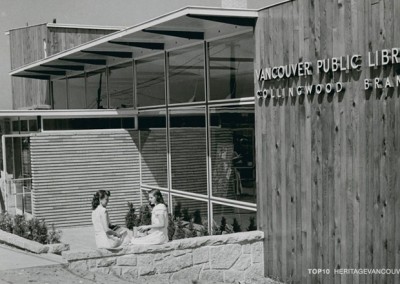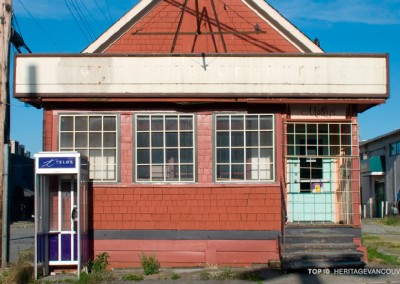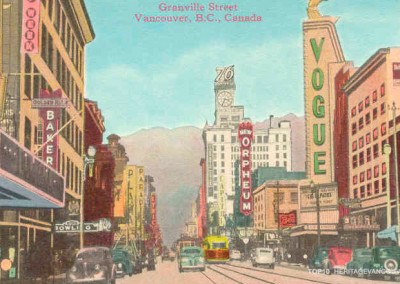Strathcona north of Hastings Street continues to fall into neglect and no steps have been taken to protect the heritage of Vancouver’s oldest neighbourhood in the past year. The major threat to the historic context of the neighbourhood may turn out to be the replacement of heritage homes with high-rise towers for social housing, due to the urgent need for affordable housing.
Threat
What is the threat to Strathcona North?
While Strathcona south of Hastings Street has undergone a revival in recent years, the area north of Hastings Street is falling into neglect.
The area is bounded by Main Street on the west, Hastings on the south, Heatley Avenue on the east and the Port and the CPR tracks to the north. A combination of changes in traditional neighbourhood-to-port access patterns, which was crucial to the neighbourhood’s initial development and demographic vitality, and past and current city zoning and planning policies have alienated the north and south parts of Strathcona from each other.
Much of the existing historic building stock north of Hastings is owned by the City of Vancouver, and the City has not developed a comprehensive plan for this neighbourhood. These conditions along with the drastic increase in poverty, drug addiction, homelessness and associated crime in the area, have undermined its economic viability, and have led to ongoing neglect and erosion of the area’s historic building stock.
Currently, the City Planning Department has inconsistent definitions of what constitutes both Strathcona and the Downtown Eastside, depending often on the reason for the definition. As a result of this muddle, development has been uncoordinated and fragmented, with no comprehensive vision for the future of Strathcona.
Significance
Why is Strathcona North of Hastings significant?
Strathcona, north of Hastings Street, is the home of some of Vancouver’s oldest built heritage.
Its proximity to the earliest major employer in the area, Hastings Mill at the foot of Dunlevy Street, meant that Vancouver’s first neighbourhood developed immediately to the south and east of the mill.
At first, most of the mill’s housing, both for workers and management stood on land which now lies north of the CPR tracks.
By the 1880s, houses including those of mill manager R. H. Alexander, Dr. Duncan Bell-Irving, and canneryman H.O. Bell-Irving, and others, stood along Alexander Street.
Nearby on the 300-block of East Cordova stood the house of Vancouver’s first Mayor, Malcolm Alexander MacLean. From the very beginning this area was a mixed neighbourhood, both in its housing and in its intimate connection to the industry and commerce of the port.
The neighbourhood has had a deep connection with Vancouver’s Japanese Canadian Community and many of the historical houses, hotels, churches, tenements and apartment buildings that remain were built by or for Japanese Canadians or have significant Nikkei history.
Alexander Street was home to a thriving Red Light District for a number of decades in the early 20th century. Many of the character houses and buildings that remain on that street date from the time there was an influx of madams to the neighbourhood after the closure of the Red Light District on Shore Street.
The neighbourhood contains a number of impressive commercial buildings and historic houses particularly along Railway, Powell and East Hastings Streets.
Of these, the Modernist Empire Stevedoring Company Offices on Railway are worthy of particular note. Some of the buildings in the neighbourhood are on the Heritage Register, including the Japanese Hall at 475 Alexander, the Coroner’s Court (Vancouver Police Museum) at 238-240 East Cordova, The Firehall Theatre at 280 East Cordova, St. James Church and Rectory at 303 East Cordova, St. Luke’s Home at 309 East Cordova, and the house believed to be the oldest standing house in Vancouver, 385 East Cordova. However, only a minority of the buildings noted in the register are protected through heritage designation.
Recent heritage studies, with a focus on old Japantown, have been carried out in the area immediately surrounding Oppenheimer Park. There are many other significant historic buildings in this area worthy of protection; two Angelo Calori houses on the 600 block of East Cordova and the houses at 412 and 414 Alexander to name only a few.
History
The entire East End neighbourhood went through a prolonged period of enforced deterioration after the Bartholomew Plan of 1928 inspired Vancouver’s first zoning by-law that zoned the area from Dunlevy to Clark as six-storey industrial. After the failed attempt by the City to wipe out the resulting “urban blight” through wholesale demolition of the neighbourhood’s existing Victorian and Edwardian houses and the construction of high-rise project housing, the remaining heritage structures below the alleyway south of Hastings were protected by a new, specially designed zoning called RT3.
No such protective zoning was provided for built heritage along Hastings Street or to the north of it.
The expulsion of the neighbourhood’s Japanese Canadian community in 1942 and the appropriation of their property in the neighbourhood left the City of Vancouver with a sizeable amount of real estate in the neighbourhood, including single family dwellings, old tenement buildings, commercial buildings and hotels.
The Japanese Canadian community re-established some roots in the neighbourhood after the war, through such community anchors as the Buddhist Temple on Jackson, the Sakura-So Seniors Home on Powell, the Japanese Hall and Language School on the 400-block of Alexander, some commercial outlets on the blocks of Powell between Jackson and Gore, as well as the annual Powell Street Festival. Despite this, the Japanese Canadian Community’s focus shifted elsewhere with the establishment of the National Nikkei Museum and Heritage Centre in Burnaby.
In 2008, the City carried out a heritage study with a focus on old Japantown, in the area immediately surrounding Oppenheimer Park. The study did not include the bulk of the Northern sector of Strathcona.
Position
Heritage Vancouver’s Position
Heritage Vancouver recognizes the unique architectural heritage and social-historical value of this remnant of Old Vancouver and encourages the City to expand the area of heritage study to include all of the old houses and buildings of the Northern sector of Strathcona, and find a way to protect the built heritage that remains.
We are encouraged by the positive steps that have been taken for the retention and adaptive reuse of the portside industrial buildings on Railway Street. We urge the City to look at creative ways of ensuring the retention and restoration of the remaining historic housing and commercial building stock in the neighbourhood. We would like to see the neighbourhood remain a mixture of residential, industrial and commercial to reflect the area’s rich residential and industrial history.
Given the historic importance of this historic neighbourhood, Heritage Vancouver recommends that the City of Vancouver:
- Provide a clear definition of the Strathcona neighbourhood—one that recognizes the historic connection between Strathcona north of Hastings with Strathcona south of Hastings. Strathcona 2010: A Clear Vision For Our Community, is a neighbourhood vision statement developed by the Strathcona Revitalization Committee, an umbrella group composed of key Strathcona-based organizations including the Strathcona Property & Tenants Association (SPOTA), the Strathcona Residents Association, the Strathcona Community Centre Association, the RayCam Cooperative Association, and the Strathcona BIA. This vision statement clearly defines the boundaries of Strathcona as from Gore to Clark, and from Railway to Malkin.
- Extend RT-3 Zoning to protect existing heritage housing stock north of Hastings in the same way it does in Strathcona south of Hastings.
- Find creative ways to make East Hastings a revitalized retail zone linking the two halves of a reintegrated Strathcona.
- Initiate a comprehensive, long-term planning process for Strathcona that incorporates the existing Community Plan, RT-3 zoning and a revitalized retail zone on East Hastings.
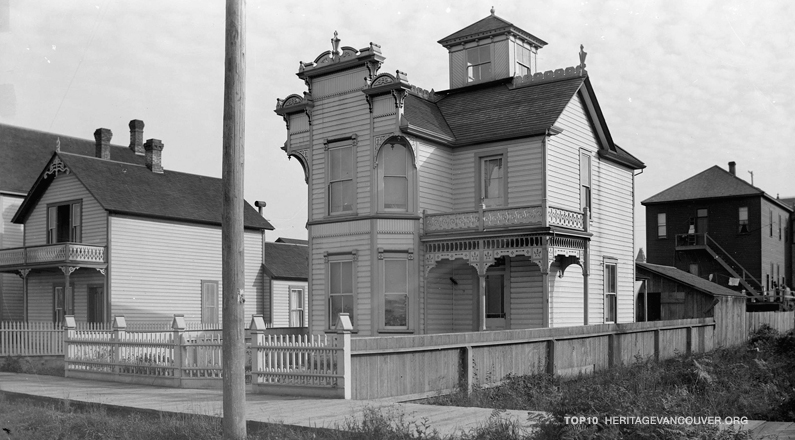

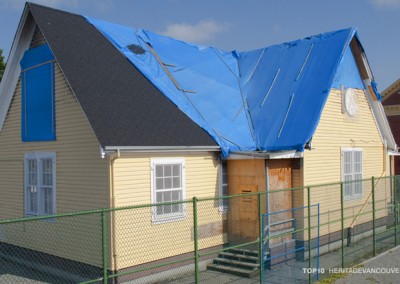
![2. Vancouver Schools: Kitchener Elementary (1914 & 1924) [lost]](https://heritagevancouver.org/wp-content/uploads/2011/11/HVS-Top10-795x440-kitchener-400x284.jpg)
![3. Vancouver Schools – J.W. Sexsmith Elementary School (1912 & 1913) [lost]](https://heritagevancouver.org/wp-content/uploads/2011/09/HVS-Top10-795x440-sexsmith-school1-400x284.jpg)
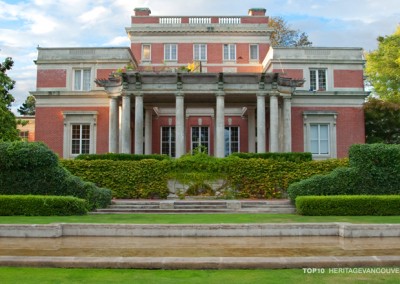
![6. Gordon T. Legg Residence (1899) [lost]](https://heritagevancouver.org/wp-content/uploads/2015/02/2013-west-end-heritage-400x284.jpg)
